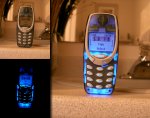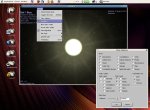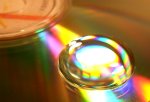XGL and Model
 This weekend was devoted to two things: getting XGL up and running and
getting some lighting tests going on the Enterprise-D.
This weekend was devoted to two things: getting XGL up and running and
getting some lighting tests going on the Enterprise-D.
XGL is really cool. It works extremely well on my desktop's ATI
Radeon 9800. It's amazing that all of the window drawing is done in
hardware. The desktop feels unbelievably snappy, probably because this
prevents programs from having to redraw on window expose events. I suspect
that they are always fully drawn, otherwise things like the Apple Exposé
work-alike would not be practical. Wobbly windows rock! The desktop cube is
awesome! Having used this desktop for most of the weekend, I really feel
very good about it. Can't wait until it gets in the mainstrean
distributions. Unfortunately, the Radeon in my laptop does not seem up to
the task.
The other half of the weekend was spent with the Enterprise-D. I finally
finished cutting out all those blasted windows. Later this week I'll finish
filling them. In the meantime, I went ahead and wired up one of the
nacelles. I'm doing photo tests along the way to make certain everything
balances nicely. It looks really, really good with anything as short as a
1/8 second exposure. I also tried lighting the saucer with two white LEDs. I
plan to have nine or twelve in there, but I was quite impressed with just
two. I ordered a bunch of super-detailed decals online last night. It's all
starting to come together. But I won't be satisfied until the moment I
remove all of the tiny pieces of masking tape that will cover all of these
windows during painting...
Typing this has been hard, as I just sliced open an important finger.
Work tomorrow will be a bitch.
[
] | posted @ 04:51 |
link
Photo Compositing
 Photo compositing is the technique of taking two or more frame-aligned
photographs and combining them to produce a single well-balanced image.
Photo compositing is the technique of taking two or more frame-aligned
photographs and combining them to produce a single well-balanced image.
The compositing technique is used heavily in motion control
photography, such as what was used on Star Trek in the days
before computer animation. In that technique, several identical camera
passes would be filmed:
- Beauty pass, showing the ship's in body in natural colour, lit as if
by a star nearby;
- Light pass, where all is black except the window lights;
- Glow ("Malibu") pass, where only the glowing parts, such as
futuristic engines, are visible;
- Strobe pass, where the strobing lights are filmed several frames on
and several frames off;
- Mask pass, where the background is brightly lit and the object in
the foreground is black.
The reason compositing is used rather than a single pass is to
overcome the limitations imposed by contrast of the individual elements.
For example, in reality, the interior lights of the Enterprise
are very weak compared to the bright light used on the exterior for the
beauty pass. When composed, one layer can be brightened independently of
any other.
In the past, as with my Klingon D-7
model, I used manual compositing. Using low-ISO film, I would hold the
shutter open for 10-15 seconds, to let the interior lights burn in
nicely. During that time, a single flash, from the direction I wanted
the beauty light from, was applied. The problem is that if the timing
was at all badly balanced, the result would not look good, and the
photograph would be wasted. It was luck as much as anything else. At the
time, individual composite shots did not make much sense, as when
scanning in the film, there is no way to ensure good alignment, and
printing digital photographs was expensive.
Welcome to 2006. Digital cameras prove to be the ideal instrument for
compositing. They have excellent light sensors, are not affected by
frame misalignment, and can preview over- or under-exposure immediately.
This afternoon, I tested my theory using a typical automatic camera
and my cell phone, which glows blue like the engines of the model I'm
currently working on. The camera was locked down on a tripod, using a
two-second timer to prevent misalignment when pushing the shutter button.
The top-left photo is the raw beauty frame, while the bottom-left is
the raw light frame. Two minutes of compositing in the Gimp
produced the image on the right. The glow can be increased or decreased
at will. The experiment is successful, in that with normal lighting, the
blue LEDs are hardly visible.
I'm excited that this technique is finally achievable without
expensive equipment. It's not enough to build a good model if it cannot
be photographed properly. I look forward to producing some amazing
images later this year.
[
] | posted @ 03:55 |
link
Celestia-Wine and Rideau Canal
 Work has been busier than usual, with several deadlines approaching
quickly. It's not that I don't have the time to blog, it's that I don't
have anything interesting to write about!
Work has been busier than usual, with several deadlines approaching
quickly. It's not that I don't have the time to blog, it's that I don't
have anything interesting to write about!
This morning I nearly made a release of Celestia 1.4.1, until some
rather critical bugs were found. I think it would be helpful if someone
stepped up to the task of taking maintainership of Windows user
interface. I get the feeling that it's more of a chore than a pleasure
at the moment.
Regardless, having downloaded the Windows installer executable, I
instinctively double-clicked on it under Linux. This launched Wine and
ran the install. Seeing as I had nothing better to do, I proceeded with
the install. To my surprise, the Windows binary runs quite well under
Linux. There are a few crashy spots and the menu bar tends to not
redraw, but it was otherwise usable. I think I'll stick to my GNOME code
for now...
After two weeks of April temperatures in the middle of the winter,
the Rideau Canal is finally open for skating. Went with my family last
night, skated the full 7.8km in both directions. What a fun experience.
There is nothing like skating under a perfectly clear sky and
enjoying beer afterwards.
[
] | posted @ 03:17 |
link
What's With The Weather?
 Never have I seen a winter like this. Last year, on this weekend, I was
coming back from Perth and it was foggy. While that was astonishing, it
doesn't compare to the last week of rain. Temperatures are high, animals
are mating early, Winterlude is destroyed, the canal is all slush. It's
winter straight from Vancouver.
Never have I seen a winter like this. Last year, on this weekend, I was
coming back from Perth and it was foggy. While that was astonishing, it
doesn't compare to the last week of rain. Temperatures are high, animals
are mating early, Winterlude is destroyed, the canal is all slush. It's
winter straight from Vancouver.
I spent all of last night filling the windows of the Enterprise-D with
clear epoxy resin. It's a little more bubbly than I would like, but it
should look good when the model is finished. As a whole, the windows in
the saucer turned out well. I've light-proofed the inside with
reflective paint and bought some lighting supplies. I'm psyched about
getting on with this.
While working with epoxy, I usually mix the resin on discarded CD-R's.
The benefit here is that the reflective background makes it apparent
when the two parts are properly mixed, because they go from their clear
individual state to a murky mix, which is much easier to see on the
reflective surface of a CD than elsewhere. Before the resin is mixed,
the perfectly clear substance refracts the colourful light from the CD
beautifully, reminding me of the "drop" effect in MacOSX.
[
] | posted @ 04:51 |
link
 This weekend was devoted to two things: getting XGL up and running and
getting some lighting tests going on the Enterprise-D.
This weekend was devoted to two things: getting XGL up and running and
getting some lighting tests going on the Enterprise-D.



